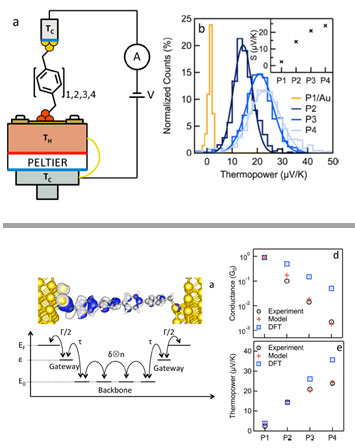Thermopower of Highly Conducting Au-C Bonded Single-molecule Circuits
October 22, 2013

TOP: Schematic set-up for simultaneous measurement of conductance and thermopower (left). Measured histograms of thermopower for a series of oligophenyl backbone molecular junctions (right). BOTTOM: Theoretical simulation of the transmitted wave incident from the left, entering the molecule through the Au-C bond orbital and then tunneling through the P4 backbone p states, together with a simplified quantum mechanical model (left). Comparison of experiment to DFT and model results (right).
What Is The Scientific Achievement?
Single molecule circuits possess high electrical conductivity and exhibit the characteristics to generate electricity from heat sources, a phenomenon called thermoelectricity. This research demonstrates that these organic molecules can have exceptionally large thermoelectric properties that can be exploited.
Why Does This Matter?
Thermoelectric effects allow the recapture of heat energy as useful electrical power. This work probes the fundamental factors that control the thermoelectric effect in the ultimate limit of single molecule junctions.
What Are The Specifics?
- Scientists at Columbia University formed and measured a series of single molecule circuits, comprised of individual molecules that were attached to gold electrodes. The measured thermoelectric properties as a function of molecule length were studied.
- CFN’s Theory and Computation Facility simulated the electronic properties of the molecules, explaining the observed thermoelectric power generated.
Reference
Length-Dependent Thermopower of Highly Conducting Au−C Bonded Single Molecule Junctions
J. R. Widawsky,† W. Chen,§ H. VaÌ?zquez,† T. Kim,†,§ R. Breslow,§ M. S. Hybertsen,‡ and L. Venkataraman†
†Department of Applied Physics and Applied Mathematics, Columbia University, New York, New York, United States
‡Center For Functional Nanomaterials, Brookhaven National Laboratory, Upton, New York, United States
§Department of Chemistry, Columbia University, New York, New York, United States
Nano Letters 13, 2889-2894 (2013).
Acknowledgment of Support
Overall project coordination, measurements, and sample synthesis were supported as part of the Center for Re-Defining Photovoltaic Efficiency Through Molecular-Scale Control, an Energy Frontier Research Center funded by the U.S. Department of Energy (DOE), Office of Science, Office of Basic Energy Sciences under Award DE-SC0001085. Part of this work was carried out at the Center for Functional Nanomaterials, Brookhaven National Laboratory, which is supported by the U.S. Department of Energy, Office of Basic Energy Sciences, under contract no. DE-AC02-98CH10886. H.V. and T.K. were supported through the Nanoscience and Engineering center by the New York State Office of Science, Technology, and Academic Research (NYSTAR). L.V. thanks the Packard Foundation for support.
2013-4399 | INT/EXT | Newsroom









